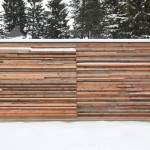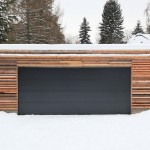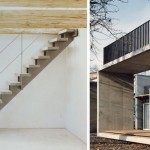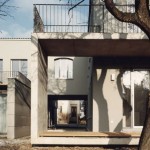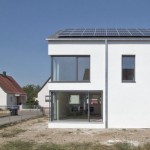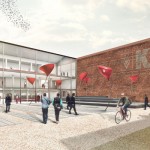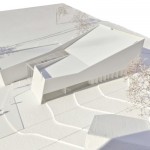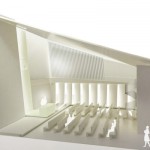Talking Stuttgart Creativity: Reichel Schlaier Architekten
“Potentially it is the simplest assignments, unencumbered by the complex mix of functional, technical or economic conditions, that allow an especially eloquent architecture”
So mused the Sachsen branch of the German Architects Association, BDA, in awarding a “Special Recognition” in the 2013 BDA-Preis Sachsen to the project “Garage in Holzstapelbauweise” by Stuttgart based Reichel Schlaier Architekten.
Created for a private client in the village of Marienberg, Sachsen, Garage in Holzstapelbauweise is, as the name implies – assuming you can read German – a garage constructed as a pile of wood, and was the very first project realised by Reichel Schlaier Architekten a.k.a. Elke Reichel and Peter Schlaier.
Elke Reichel studied architecture at the TU Dresden and the Mackintosh School of Architecture, Glasgow. Following a tenure with Littman Goddard Hogarth Architects in London, Elke Reichel joined Behnisch & Partner, Stuttgart in 2001 where she met Ulm native and Stuttgart University graduate Peter Schlaier.
In 2011 Elke Reichel and Peter Schlaier established Reichel Schlaier Architekten.
In addition to the Marienberg garage project Reichel Schlaier Architekten have completed projects in Stuttgart, Neu-Ulm and Limbach-Oberfrohna and are currently developing a range of domestic, commercial and social projects. The pair also hold numerous teaching positions and Elke Reichel was recently voted onto the Executive Committee of the German Architects Association, BDA.
As part of our Talking Stuttgart Creativity series we visited Elke Reichel and Peter Schlaier and spoke to them about architecture competitions, an architect’s responsibility and Stuttgart as a creative city, but started by asking about the challenges of establishing yourself as a new, young, architecture bureau……
Elke Reichel: The dream is always to open an office, win a few competitions and then very quickly grow to become an even larger office. But it doesn’t work like that. At the beginning it is often enough of a challenge just financing yourself and your small office, not least because the payment generally comes at the end of the process. If at all. We, for example, won some competitions early on, but they then subsequently weren’t commissioned. And so survival is the first imperative. And that involves taking on smaller jobs, doing them well and then hoping that you are recommended further. We were, and these recommendations secured our early survival.
Peter Schlaier: We started with relatively small projects, including several attic extensions and office redevelopments, which initially was a little difficult. We came from a world of large projects, with Behnisch we were, for example, both responsible for the Ozeaneum project in Stralsund as project managers, and so we are use to working on large projects, are familiar with what needs to be done and how such projects should be managed and controlled, but initially no one gives you the chance when you set up on your own. For example, you’re often not even given the chance to enter limited competitions. And so this switch to smaller projects wasn’t the easiest, fortunately that has all now changed a little.
(smow)blog: Yet remains an experience which poses the question, is it more difficult to establish yourself in a city such as Stuttgart where there are so many architects, or….
Elke Reichel: No, I’d say the opposite and that it is a little easier in Stuttgart because here one has a population who have a little more money, greater financial stability and security. There’s not that many super rich here, but a lot of financially very comfortable individuals and families, which makes things a lot easier. Plus here in Stuttgart the various crises of the last few years haven’t had that much effect, or at least have had less effect than perhaps elsewhere.
Peter Schlaier: Also here in the region one has a large number of financially secure small and medium sized businesses and institutions. We for example currently have two larger projects in development, the first is a church on Bodensee, and going back to the importance of smaller projects in helping establishing a practice, they approached us after seeing the Marienberg garage, and the second is for the high pressure cleaner manufacturer Kärcher, and they also became aware of us through a smaller project and invited us to compete in a limited competition. Which we fortunately won. And such projects are not the sort that, I imagine, one would find so often elsewhere in Germany.
Elke Reichel: One also has the situation that once Stuttgart bureaus reach a certain size they tend to start working more nationally and internationally and less in Stuttgart, which means that although there are a lot of architects in Stuttgart there isn’t necessarily a lot of competition between the bureaus, and so in effect there is enough room here for us all.
(smow)blog: Competitions is a nice keyword, as a non-architect one often has the impression that architecture competitions are an awful lot of work for potentially no return. Does it make sense to enter such competitions, or are they simply one of those necessary professional evils?
Elke Reichel: One obviously doesn’t need to participate in competitions, especially in a region such as this where there are enough projects available without competitions, and potentially acquiring work is simpler if you don’t participate. However, there are a lot of projects that as an architect you would like the chance to realise, projects where one can be truly creative and can truly create something that comes from you, and such projects are generally only commissioned through competitions.
Peter Schlaier: It is essentially a question of winning enough competitions so that one can spread the costs over the rest of the year. Which means that larger practices with an in-house competition team who enter dozens of competitions per year can be certain of winning enough to make it profitable, and so attractive. For smaller practices it is a lot less certain, especially if your only actually given the chance to enter a relatively small number of competitions. Then you may be looking at spreading costs over several years, and that is naturally a less attractive proposition.
Elke Reichel: And then, as before, the project must subsequently be commissioned….
(smow)blog: You mentioned developing projects where one can be truly creative. Without wanting to necessarily discuss the role of architects, what do you understand as the responsibility of an architect today?
Elke Reichel: As an architect one has an immense social responsibility, ultimately what you create will, all things being equal, be around for generations to come. And so with every decision we make we design our immediate environment, our communities, and that for me is inspiring, but also involves accepting a great deal of responsibility. And so I think the most important thing is simply to do your job well, in all aspects and in all respects
Peter Schlaier: To which I’d have to add that this responsibility is often poorly understood. All too often a building is ultimately only as good as the client wants it to be. And there are sadly developers and Bauherrn in Germany who simply don’t have the interest in developing genuinely good projects. And so while yes the architects have a social responsibility, the wider community has also a responsibility to ensure they demand the best an architect can deliver. And not just a quick, cheap fix. We all know that when in a town centre an inappropriate building is created that the architects are guilty, but as an architect you only have so much influence and can only make so many decisions. Yes one could try to go the Peter Zumthor way and say if the client doesn’t want my building then I’ll not build it. But then someone else will build what the client wants; consequently, such an approach doesn’t solve the problem. And so the wider community needs to realise the importance of getting architecture right.
(smow)blog: To end, we touched earlier on Stuttgart, but is Stuttgart a good city to be creative in? Is Stuttgart a creative city?
Elke Reichel: Stuttgart is a busy city. It seems that one is permanently dealing with people who are involved with big projects or interesting, relevant projects. Small talk in Stuttgart is rarely about unimportant, superficial matters, but things that are actually happening and important. Which makes it a genuinely interesting city to work in.
Peter Schlaier: One notices that people are doing things. If you’ve got an idea you follow it through. In Stuttgart it’s not just people talking big, there are actually real projects happening behind what they are saying. And that is pleasant. Plus there are no “clubs” here, everyone has the same chances, and there is no need to have the correct connections in order to be successful.
- Garage Holzstapelbauweise in Marienberg, Sachsen by Reichel Schlaier Architekten, Stuttgart (Photo: Johannes-Maria Schlorke)
- Garage Holzstapelbauweise in Marienberg, Sachsen by Reichel Schlaier Architekten, Stuttgart (Photo: Johannes-Maria Schlorke)
- Limbach-Oberfrohna – conversion of a former glove factory to flats by Reichel Schlaier Architekten, Stuttgart (Photo: Reichel Schlaier Architekten)
- Limbach-Oberfrohna – conversion of a former glove factory to flats by Reichel Schlaier Architekten, Stuttgart (Photo: Reichel Schlaier Architekten)
- Haus U, Neu-Ulm by Reichel Schlaier Architekten, Stuttgart (Photo: Reichel Schlaier Architekten)
- Conversion of the Kärcher “Alte Ziegelei” in Winnenden by Reichel Schlaier Architekten, Stuttgart (Graphic: Reichel Schlaier Architekten)
- New adminitrative office for Kärcher in Winnenden by Reichel Schlaier Architekten, Stuttgart (Graphic: Reichel Schlaier Architekten)
- New Apostolic Church in Überlingen am Bodensee by Reichel Schlaier Architekten, Stuttgart (Graphic: Reichel Schlaier Architekten)
- New Apostolic Church in Überlingen am Bodensee by Reichel Schlaier Architekten, Stuttgart (Graphic: Reichel Schlaier Architekten)
Tagged with: Architecture, Elke Reichel, Peter Schlaier, Reichel Schlaier Architekten, Stuttgart
